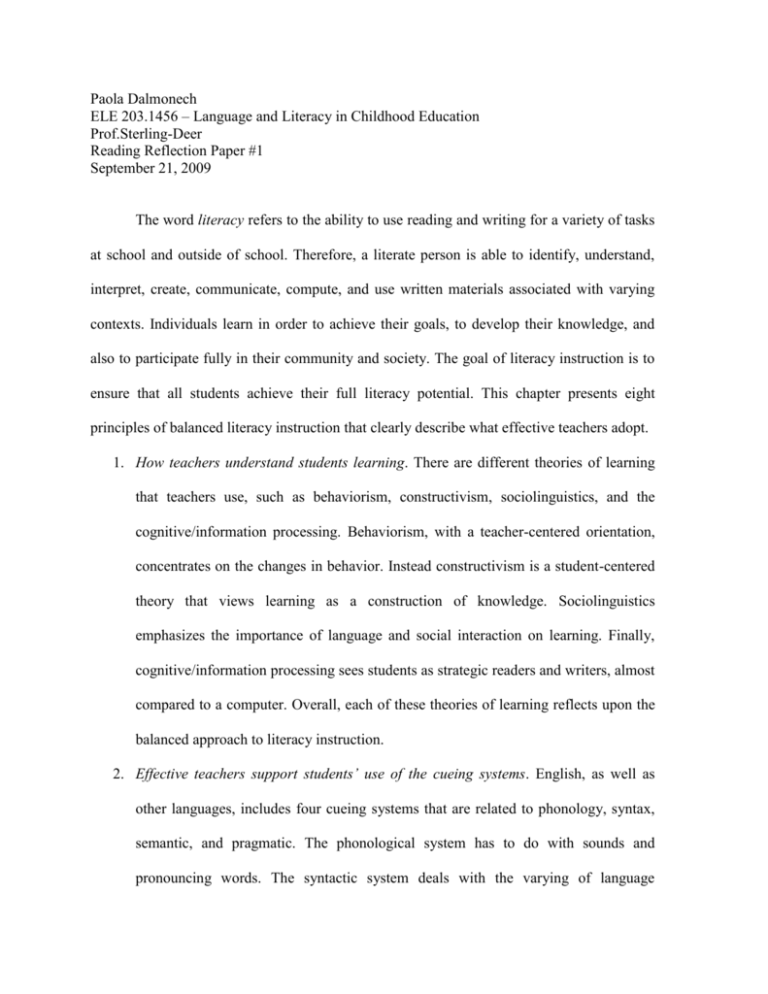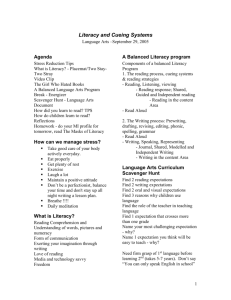Assignment #1
advertisement

Paola Dalmonech ELE 203.1456 – Language and Literacy in Childhood Education Prof.Sterling-Deer Reading Reflection Paper #1 September 21, 2009 The word literacy refers to the ability to use reading and writing for a variety of tasks at school and outside of school. Therefore, a literate person is able to identify, understand, interpret, create, communicate, compute, and use written materials associated with varying contexts. Individuals learn in order to achieve their goals, to develop their knowledge, and also to participate fully in their community and society. The goal of literacy instruction is to ensure that all students achieve their full literacy potential. This chapter presents eight principles of balanced literacy instruction that clearly describe what effective teachers adopt. 1. How teachers understand students learning. There are different theories of learning that teachers use, such as behaviorism, constructivism, sociolinguistics, and the cognitive/information processing. Behaviorism, with a teacher-centered orientation, concentrates on the changes in behavior. Instead constructivism is a student-centered theory that views learning as a construction of knowledge. Sociolinguistics emphasizes the importance of language and social interaction on learning. Finally, cognitive/information processing sees students as strategic readers and writers, almost compared to a computer. Overall, each of these theories of learning reflects upon the balanced approach to literacy instruction. 2. Effective teachers support students’ use of the cueing systems. English, as well as other languages, includes four cueing systems that are related to phonology, syntax, semantic, and pragmatic. The phonological system has to do with sounds and pronouncing words. The syntactic system deals with the varying of language according to social and cultural uses. The semantic system focuses on the meaning of words, and ultimately, the pragmatic system deals with the varying of language according to social and cultural uses. 3. Classrooms function as communities of learners. They should represent a safe and pleasant place where students would feel at their ease, and consequently, they would begin to be more motivated to learn. In short, classrooms are social settings available for the students to familiarize with their members. 4. Effective teachers adopt a balanced approach to instruction that is based on a comprehensive view of literacy that combines explicit instruction, guided practice, collaborative learning, and independent reading and writing. The characteristics of the balanced approach are embodied in an instructional program that includes components, such us reading, writing, spelling, phonics, literature, and oral language. 5. The five stages of support. Teachers, in order to scaffold students’ reading and writing activities, use the levels of modeling, sharing, interacting, guiding, and working independently. 6. Teachers organize their own programs for literacy instruction. Four of the most popular programs are basal reading, literature focus units, literature circles, and reading and writing workshops. Moreover, teachers adapt these programs for those minority students who are learning to speak English at the same time they are developing literacy. 7. Effective teachers link instruction and assessment. This occurs because they want to monitor and keep track of students’ reading and writing progress and ensure that they are meeting district and state standards. 8. Teachers become partners with parents. Parents are important figures for their children, and especially for their children’s literacy development and academic success. There are several ways for teachers to get parents involved in their children’s reading and writing development. One of the most used, I believe, is the homeliteracy activity that sees parents reading books aloud to children. What I think deserves consideration and comment is the eighth principle. In other words, it is interesting looking at the way teachers try to work with parents for the intention of improving children’s reading and writing development. The textbook well examines one of the recommendations, which is called “home-literacy activities”. It is extremely significant that parents engage their kids in reading even after a regular school day. Furthermore, one of the ways teachers most often highly suggest is the Family Book Clubs system that observes parents and children reading and discussing books together. I believe this is a very effective way for children to learn how to appreciate the reading of a book, also because they are encouraged by their parents who undoubtedly represent trustworthy and loyal figures. In this sense, many parents can actively support their children’s literacy.









